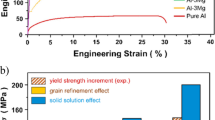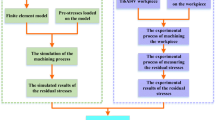Abstract
The use of micro/nano-scale machining in the production of miniaturized products that are used in various industrial applications such as biotechnology, electronics, optics, medicine, and aviation has increased drastically in the past two decades. To maintain the functional quality of these products, it is essential to investigate and know the machining parameters that are needed to produce high-quality products. An attempt was made to investigate the effects of tool geometry, cutting speed, and undeformed chip thickness on the residual stresses and quality of the machined surface using an orthogonal micro-machining process. A modified deflection-etching technique was used for the residual stress analysis and determination, and the machined surfaces were examined using a scanning electron microscope. For the cutting conditions used in this experiment, compressive residual stresses were formed in the surface region. Surface damage in the form of grooves, cracks, voids, fractured areas, and scratches were observed for all the specimen machined in this study. The radius of the tool cutting edge measured from the photomicrograph of the scanning electron microscope was approximately 50 µm, which was higher than the depth of the undeformed chip thicknesses used in this work, which resulted in an inefficient cutting process wherein a significant portion of the energy was expended to plastically deform the machined surface region. This has led to surface damage in the form of grooves, cracks, voids, fractured areas, and scratches and induced compressive residual stresses in the surface region.


















Similar content being viewed by others
Data availability
Data is included.
References
Samul J, Jun M, Ozdoganlar O et al (2020) Micro/meso-scale mechanical machining 2020: a two-decade state-of-the-field review. J Manuf Sci Eng 142:110809. https://doi.org/10.1115/1.4047621
Dornfeld D, Min S (2006) Recent advances in mechanical micromachining. CIRP Ann 55(2):745–768. https://doi.org/10.1016/j.cirp.2006.10.006
Liu X, DeVor RE, Kapoor SG, Ehmann KF (2004) The mechanics of machining at microscale: assessment of the current state of the science. J Manuf Sci Eng 126(4):666–678. https://doi.org/10.1115/1.1813469
Lauro C, Brandao L, Panzera T, Davim J (2015) Surface integrity in the micromachining: a review. Adv Mater Sci 40:227–234
Rahman MA, Amrun M, Rahman M, Kumar A (2017) Variation of surface generation in ultr-precision machining due to relative tool sharpness (RTS) and material properties. Int J Mach Tools Manuf 115:15–28. https://doi.org/10.1016/j.ijmachtools.2016.11.003
Arai S, Wilson S, Corbett J, Whatmore R (2009) Ultra-precision grinding of pzt ceramics-surface integrity control and tooling design. Int J Mach Tools Manuf 49:998–1007. https://doi.org/10.1016/j.ijmachtools.2009.05.013
Imran M, Mativenga P, Gholinia WP (2014) Comparison of tool wear mechanism and surface integrity for dry and wet micro-drilling of nickel-base superalloys. Int J Mach Tools Manuf 76:49–60. https://doi.org/10.1016/j.ijmachtools.2013.10.002
Kwong J, Axinte D, Withers P (2009) The sensitivity of Ni-base superalloy to hole making operation: influence of process parameters on surface damage and residual stress. J Mater Process Technol 209(8):3968–3977. https://doi.org/10.1016/j.jmatprotec.2008.09.014
Gou X, Dong Z (2022) Effect of cutting force on formation of subsurface damage during nano-cutting of single-crystal tungsten. J Manuf Sci Eng 144:111008. https://doi.org/10.1115/1.4054839
Luan Y, Lu X, Hou P, Liang S (2021) Characteristics and mechanism of top burr formation in micro-milling LF21. J Manuf Sci Eng 143:071004. https://doi.org/10.1115/1.4049650
Ernst H, Merchant ME (1941) Chip formation, friction and high quality machined surface, in surface treatment of metals. Am Soc Metals New York 29:299
Albrecht P (1960) New development in the theory of the metal-cutting process, part I. the ploughing process in metal cutting. Trans ASME 82(4):348–358. https://doi.org/10.1115/1.3664242
Sadat A, Bailey J (1987) Residual stresses in turned AISI4340 steel. J Exp Mech 27(1):80–85. https://doi.org/10.1007/BF02318868
Lucca D, Rhorer R, Komanduri R (1991) Energy dissipation in the ultraprecision machining of copper. CIRP Ann 40(1):69–72. https://doi.org/10.1016/S0007-8506(07)61936-2
Lucca D, Seo Y (1993) Effect of tool geometry on energy dissipation in ultraprecision machining. CIRP Ann 42(1):83–86. https://doi.org/10.1016/S0007-8506(07)62397-X
Tamininiau D, Dautzenberg J (1991) Bluntness of the tool and process forces in high precision cutting. CIRP Ann 40(1):65–68. https://doi.org/10.1016/S0007-8506(07)61935-0
Komanduri R, Chandrasekaran N (1999) Some aspects of machining with negative-rake tools simulating grinding: a molecular dynamic simulation approach. Philos Mag B 79(7):955–968. https://doi.org/10.1080/13642819908214852
Komanduri R (1971) Some aspects of machining with negative rake tools simulating grinding. Int J Mach Tool Des Res 11(3):223–233. https://doi.org/10.1016/0020-7357(71)90027-8
Abdelmonein MES, Scrutton RF (1974) Tool edge roundness and stable built-up formation in finish machining. Trans ASME 96(4):1258–1267. https://doi.org/10.1115/1.3438504
Brinksmeier E, Commett J, Konig W et al (1982) Residual stresses-measurement and causes in machining processes. CIRP Ann Manuf Technol 31(2):491–510. https://doi.org/10.1016/S0007-8506(07)60172-3
Klopfstein M, Riemer O (2020) Ultra-precision machining: cutting with diamond tools. J Manuf Sci Eng 142:110817–110915. https://doi.org/10.1115/1.4048194
Colwell L, Sinnot M, Tobin JC (1955) The determination of residual stress in hardened, ground steel. Trans ASME 77:1099–1105. https://doi.org/10.1115/1.4014606
Tsuchida K, Kawada Y, Kudama S (1975) A study of the residual stress distributions by turning. Bull JSME 18(116):123–130. https://doi.org/10.1299/jsme1958.18.123
Author information
Authors and Affiliations
Corresponding author
Ethics declarations
Competing interests
The authors declare no competing interests.
Additional information
Publisher's Note
Springer Nature remains neutral with regard to jurisdictional claims in published maps and institutional affiliations.
Rights and permissions
Springer Nature or its licensor (e.g. a society or other partner) holds exclusive rights to this article under a publishing agreement with the author(s) or other rightsholder(s); author self-archiving of the accepted manuscript version of this article is solely governed by the terms of such publishing agreement and applicable law.
About this article
Cite this article
Sadat, A. Residual stresses and surface damage when micromachining 6061-T6 aluminum alloy. Int J Adv Manuf Technol 130, 4469–4477 (2024). https://doi.org/10.1007/s00170-023-12926-5
Received:
Accepted:
Published:
Issue Date:
DOI: https://doi.org/10.1007/s00170-023-12926-5




